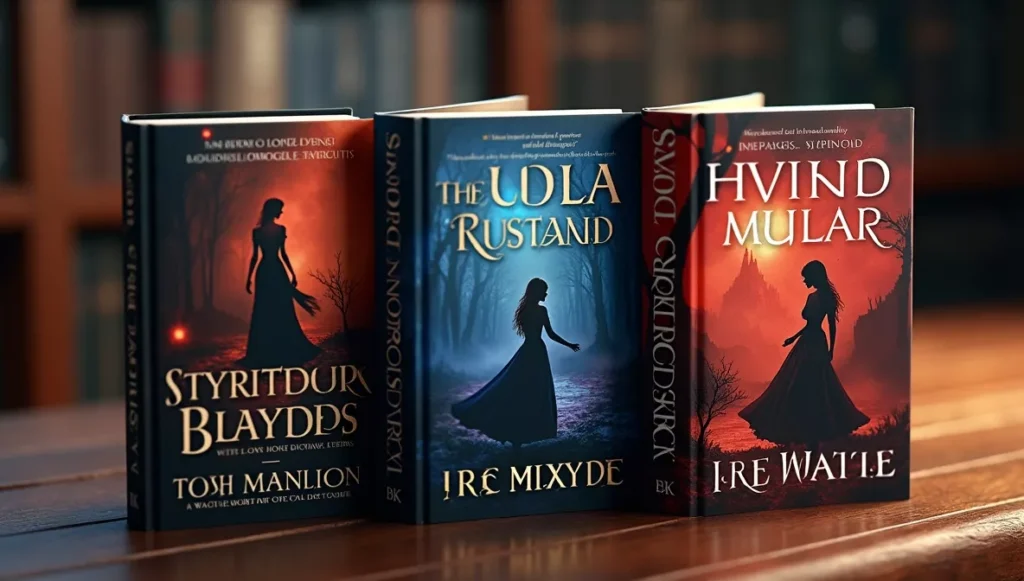Your Book Cover is Your First Hello
Imagine walking into a massive bookstore with thousands of books. What makes you pick up one book instead of another? The cover, right?
- Your Book Cover is Your First Hello
- Why Book Covers Matter So Much
- People Do Judge Books by Their Covers
- Your Cover is Your Best Marketing Tool
- 💖 You Might Also Like
- Standing Out in a Crowded Market
- What Makes a Great Book Cover?
- Clear and Simple Design
- Genre Appropriate
- Professional Typography
- High-Quality Images
- The Right Emotions
- The Best AI Tools for Creating Book Covers
- 1. Midjourney – The Artist’s Dream
- ✨ More Stories for You
- 2. DALL-E 3 – The Smart Creative
- 🌟 Don’t Miss These Posts
- 3. Canva with AI Features – The Beginner’s Best Friend
- 4. Adobe Firefly – The Professional’s Choice
- 5. Leonardo.ai – The Versatile Creator
- 6. NightCafe – The Community Favorite
- 7. Recraft – The Typography Hero
- Step-by-Step: Creating Your First AI Book Cover
- Step 1: Know Your Book
- Step 2: Research Your Genre
- Step 3: Choose Your AI Tool
- Step 4: Write Your Prompt
- Step 5: Generate Multiple Options
- Step 6: Add Your Title and Name
- Step 7: Test Your Cover
- Step 8: Export in the Right Format
- Tips and Tricks for Better AI Book Covers
- Keep It Simple
- Use Negative Prompts
- Create Consistency for Series
- Consider Your Spine and Back Cover
- Get Feedback
- Don’t Be Afraid to Iterate
- Learn Basic Design Principles
- Common Mistakes to Avoid
- Mistake 1: Using Generic Stock Photos
- Mistake 2: Too Much Text
- Mistake 3: Wrong Genre Signals
- Mistake 4: Unreadable Fonts
- Mistake 5: Poor Image Quality
- Mistake 6: Ignoring Copyright
- Mistake 7: Not Testing Thumbnail Size
- Understanding AI Image Rights and Copyright
- Do You Own AI-Generated Images?
- Can Someone Else Use the Same Image?
- What About Training Data?
- Budgeting for Your Book Cover
- Free Options
- Budget-Friendly Options
- Professional Approach
- What’s Worth It?
- AI Covers vs. Hiring a Designer
- When AI Is Perfect
- When to Hire a Human
- The Hybrid Approach
- Real Success Stories
- Sarah’s Romance Series
- Mike’s Sci-Fi Thriller
- Emma’s Children’s Book
- The Future of AI Book Covers
- Better Understanding
- More Control
- Animation
- Integration
- Personalization
- Your Action Plan: Getting Started Today
- Week 1: Research and Learn
- Week 2: Experiment
- Week 3: Refine
- Week 4: Finalize
- Frequently Asked Questions
- Conclusion: Your Beautiful Cover Awaits
Your book cover is like a handshake. It’s the first thing readers see. It tells them what your book is about without reading a single word. A great cover can make someone stop scrolling and say, “Wow, I need to read this!”
But here’s the problem: hiring a professional designer can cost hundreds or even thousands of dollars. Not every self-published author or indie writer has that kind of money, especially when starting out.
That’s where AI comes to save the day!
AI tools can now create beautiful, professional-looking book covers in minutes. You don’t need to be an artist. You don’t need fancy software skills. You just need the right tools and a little creativity.
In this guide, we’ll explore the best AI tools for creating book covers. We’ll make it super simple, fun, and easy to understand. Even if you’re new to all this tech stuff, you’ll be creating amazing covers by the end of this article!
Why Book Covers Matter So Much
Before we dive into the AI tools, let’s talk about why your book cover is so important.
People Do Judge Books by Their Covers
We’ve all heard the saying, “Don’t judge a book by its cover.” But guess what? Everyone does it anyway!
Studies show that readers make a decision about a book in less than 5 seconds. That’s faster than you can say “supercalifragilisticexpialidocious!” Your cover needs to grab attention immediately.
A good cover tells readers:
- What genre your book is
- The mood and tone of your story
- That your book is professional and worth their time
- That you care about quality
Your Cover is Your Best Marketing Tool
Think of your cover as a tiny billboard for your book. It appears on Amazon, social media, in emails, and everywhere you promote your book. A professional cover makes people take you seriously as an author.
💖 You Might Also Like
A bad cover? It makes readers scroll right past your book, no matter how amazing your story is inside.
Standing Out in a Crowded Market
Thousands of new books are published every single day. Your cover needs to stand out from the crowd. It needs to be different, eye-catching, and memorable.
AI tools can help you create unique covers that don’t look like everyone else’s. You can experiment with different styles until you find something that feels perfectly “you.”
What Makes a Great Book Cover?
Before we look at AI tools, let’s understand what makes a cover work.
Clear and Simple Design
The best covers are usually simple. They’re not too busy or cluttered. You should be able to see the title clearly, even when the cover is shown as a tiny thumbnail on Amazon.
Think about some famous book covers you know. Harry Potter. The Hunger Games. Twilight. They’re all pretty simple, right? But they’re powerful.
Genre Appropriate
Every book genre has its own “look.” Romance novels often have couples or beautiful scenery. Thrillers have dark colors and mysterious images. Children’s books have bright colors and fun illustrations.
Your cover should fit your genre so readers immediately know what type of book it is.
Professional Typography
The fonts you choose matter a lot! The title should be easy to read and match the mood of your book. Scary fonts for horror. Elegant fonts for romance. Bold fonts for action.
AI tools usually have lots of font options to choose from, making this part easier.
High-Quality Images
Blurry, pixelated images make your book look cheap and unprofessional. AI tools create high-resolution images that look crisp and clear, even when printed.
The Right Emotions
Your cover should make readers feel something. Excitement. Curiosity. Fear. Love. Whatever emotion your book delivers, your cover should hint at it.
The Best AI Tools for Creating Book Covers
Now for the fun part! Let’s explore the best AI tools available for self-published authors and indie writers.
1. Midjourney – The Artist’s Dream
Midjourney is like having a super talented artist at your fingertips. It creates stunning, artistic images based on text descriptions you give it.
How It Works:
✨ More Stories for You
You type a description like “a mysterious castle at sunset with purple skies” and Midjourney creates beautiful artwork for you. You can keep tweaking your description until you get exactly what you want.
Why Authors Love It:
- Creates incredibly detailed, artistic images
- Perfect for fantasy, sci-fi, and literary fiction covers
- You can create truly unique imagery that nobody else has
- Great for authors who want artistic, painterly covers
The Learning Curve:
Midjourney requires learning how to write good “prompts” (descriptions). It takes practice, but there are tons of tutorials online to help you.
Cost:
Starts at around $10 per month for a basic subscription. You get to create lots of images for that price.
Best For:
Authors who want artistic, one-of-a-kind covers and don’t mind spending time learning the tool.
2. DALL-E 3 – The Smart Creative
DALL-E 3, created by OpenAI, is another powerful AI image generator. It understands your descriptions really well and creates images that match what you’re imagining.
How It Works:
Similar to Midjourney, you describe what you want, and DALL-E creates it. It’s great at understanding complex descriptions and creating cohesive images.
Why Authors Love It:
- Excellent at following detailed instructions
- Creates consistent characters and scenes
- Good for all genres
- Easy to use through ChatGPT Plus
The Learning Curve:
DALL-E is pretty user-friendly. If you can describe what you want in a sentence, you can use DALL-E.
Cost:
🌟 Don’t Miss These Posts
Available through ChatGPT Plus subscription at $20 per month, which gives you access to other AI tools too.
Best For:
Authors who want high-quality images and are already using ChatGPT for writing help.
3. Canva with AI Features – The Beginner’s Best Friend
Canva is a design platform that many people already know and love. They’ve added powerful AI features that make creating book covers super easy.
How It Works:
Canva provides templates specifically for book covers. You can use their AI image generator called “Magic Media” to create custom images, or choose from millions of stock photos. Then you add your title, author name, and adjust colors.
Why Authors Love It:
- Extremely user-friendly – if you can drag and drop, you can use Canva
- Has pre-made book cover templates for every genre
- Provides proper dimensions for ebook and print books
- All-in-one solution – create your cover and export it ready to upload
- Has free and paid options
The Learning Curve:
Almost none! Canva is designed for people with zero design experience.
Cost:
Free version available with lots of features. Canva Pro costs about $13 per month and unlocks premium templates and AI features.
Best For:
Complete beginners who want professional results without a learning curve.
4. Adobe Firefly – The Professional’s Choice
Adobe Firefly is Adobe’s AI image generator. Adobe is the company that makes Photoshop, so they know a thing or two about images!
How It Works:
You describe your image, and Firefly creates it. You can then fine-tune it using Adobe’s professional tools if you want.
Why Authors Love It:
- Creates commercial-safe images (important for avoiding copyright issues)
- Integrates with other Adobe tools
- High-quality, professional results
- Good control over the final image
The Learning Curve:
Medium. Firefly itself is easy to use, but you might want to learn some Adobe Express or Photoshop to get the most out of it.
Cost:
Free plan available with limited generations. Premium plans start around $5 per month.
Best For:
Authors who want professional-grade images and might want to edit them further.
5. Leonardo.ai – The Versatile Creator
Leonardo.ai is a newer AI tool that’s becoming really popular with book cover designers. It offers great control over the style and look of your images.
How It Works:
You write a prompt describing your cover, choose a style (realistic, artistic, anime, etc.), and Leonardo creates options for you.
Why Authors Love It:
- Lots of style options in one place
- Consistent results across multiple images
- Good for creating series covers that match
- Reasonable pricing
The Learning Curve:
Low to medium. Pretty intuitive once you play around with it.
Cost:
Free plan available with limited features. Paid plans start at $10 per month.
Best For:
Authors creating series who need consistent-looking covers.
6. NightCafe – The Community Favorite
NightCafe is an AI art generator with a friendly community of creators who share tips and inspiration.
How It Works:
Choose from different AI models, describe what you want, and NightCafe generates your image. You can use various styles from photorealistic to artistic.
Why Authors Love It:
- User-friendly interface
- Daily free credits to create images
- Community gallery for inspiration
- Multiple AI engines to choose from
The Learning Curve:
Low. Easy to get started right away.
Cost:
Free tier available with daily credits. Paid plans start around $5 per month.
Best For:
Authors who want to experiment without spending much money upfront.
7. Recraft – The Typography Hero
Recraft is newer on the scene but has amazing features for text and typography, which is crucial for book covers.
How It Works:
Create images with AI and add text that actually looks good. Recraft is especially good at integrating text into designs.
Why Authors Love It:
- Excellent typography tools
- Easy to create text-heavy covers
- Clean, professional results
- Good for non-fiction book covers
The Learning Curve:
Low. Designed to be user-friendly.
Cost:
Free plan available. Pro plans around $20 per month.
Best For:
Non-fiction authors who need text-heavy covers.
Step-by-Step: Creating Your First AI Book Cover
Let’s walk through creating a book cover using AI. We’ll use a simple example that works with most AI tools.
Step 1: Know Your Book
Before touching any tool, answer these questions:
- What’s your book’s genre?
- What’s the main theme or feeling?
- Who are your main characters?
- What’s the setting?
- What emotion should readers feel when they see the cover?
Write down your answers. These will help you create better prompts.
Step 2: Research Your Genre
Go to Amazon and look at the bestselling books in your genre. What do their covers look like?
Notice:
- Common colors
- Types of images used
- Font styles
- How much text vs. image
- What makes some covers stand out
You’re not copying – you’re learning what readers in your genre expect.
Step 3: Choose Your AI Tool
Based on what we discussed earlier, pick a tool that fits your needs and budget. For beginners, start with Canva or NightCafe.
Step 4: Write Your Prompt
If using an AI image generator, you need to describe what you want. Here’s a formula:
[Subject] + [Style] + [Mood] + [Details] + [Lighting]
Example for a fantasy novel: “A magical forest with glowing blue mushrooms, fantasy art style, mysterious and enchanting mood, with ancient trees and mist, soft moonlight filtering through branches”
Step 5: Generate Multiple Options
Don’t settle for the first image you create! Generate at least 10-20 options. AI is cheap and fast – use that to your advantage.
Try different:
- Descriptions
- Styles
- Colors
- Compositions
Step 6: Add Your Title and Name
Once you have an image you love, add your book title and author name. Make sure:
- The title is large enough to read in thumbnail size
- The font matches your genre
- There’s good contrast between text and background
- Your author name is visible but doesn’t overpower the title
Step 7: Test Your Cover
Before finalizing, test your cover:
- Shrink it to thumbnail size – can you still read the title?
- Show it to friends – what genre do they think it is?
- Compare it to bestsellers – does it look professional?
- How does it look in black and white? (Some stores show grayscale thumbnails)
Step 8: Export in the Right Format
Make sure you export your cover in the right size and resolution:
- For ebooks: Usually 1600 x 2400 pixels minimum
- For print: Higher resolution (300 DPI) and specific dimensions based on your book size
- Format: Usually JPG or PNG
Tips and Tricks for Better AI Book Covers
Here are some insider secrets to make your AI covers amazing:
Keep It Simple
Less is more! Don’t try to cram too much into your cover. One strong image is better than five weak ones.
Use Negative Prompts
Tell the AI what you DON’T want. For example: “no text, no watermarks, no blurry images.” This helps the AI avoid mistakes.
Create Consistency for Series
If you’re writing a series, keep similar:
- Colors schemes
- Font choices
- Layout styles
- Image types
This helps readers recognize your books as a series.
Consider Your Spine and Back Cover
If creating a print book, you need a full cover (front, spine, and back). Plan for this from the start!
Get Feedback
Show your cover to your target readers. They’ll tell you honestly if it works or not.
Don’t Be Afraid to Iterate
Your first cover doesn’t have to be perfect. Many successful authors have redesigned their covers multiple times.
Learn Basic Design Principles
Even with AI, understanding basics like:
- Color theory
- Rule of thirds
- Typography basics
- Contrast and balance
Will help you make better choices.
Common Mistakes to Avoid
Let’s talk about what NOT to do:
Mistake 1: Using Generic Stock Photos
Just slapping a stock photo on a cover screams “amateur.” AI allows you to create unique imagery – use it!
Mistake 2: Too Much Text
Your cover shouldn’t include:
- Full summaries
- Quotes
- Subtitles (unless necessary)
- Too many endorsements
Keep it clean!
Mistake 3: Wrong Genre Signals
A bright, colorful cover for a dark thriller will confuse readers. Stay true to your genre.
Mistake 4: Unreadable Fonts
Fancy doesn’t always mean good. Your title must be readable, especially in thumbnail size.
Mistake 5: Poor Image Quality
Always use the highest resolution possible. Pixelated covers look unprofessional.
Mistake 6: Ignoring Copyright
Make sure you have the rights to all images you use. With AI-generated images, read the terms of service about commercial use.
Mistake 7: Not Testing Thumbnail Size
Your cover might look great full-size but terrible as a thumbnail. Always check!
Understanding AI Image Rights and Copyright
This is important, so pay attention!
Do You Own AI-Generated Images?
It depends on the tool. Most AI services allow commercial use, but READ THEIR TERMS OF SERVICE.
Generally:
- Midjourney: You own the images with a paid subscription
- DALL-E: You can use images commercially
- Canva: You can use images with proper licensing
- Always check current terms as they can change
Can Someone Else Use the Same Image?
Technically, yes. If someone uses the same prompt, they might get a similar image. This is rare but possible.
To protect yourself:
- Create unique prompts
- Combine multiple AI images
- Add your own modifications
- Use unique typography
What About Training Data?
AI tools learn from existing images on the internet. Some artists aren’t happy about this. It’s an ongoing debate.
As an author, just make sure you’re using tools ethically and legally according to their terms.
Budgeting for Your Book Cover
Let’s talk money. How much should you spend?
Free Options
You can create decent covers with:
- Canva free version
- NightCafe free credits
- Leonardo.ai free tier
Budget: $0
Perfect for: Testing ideas or very tight budgets
Budget-Friendly Options
For $10-20 per month, you can access:
- Midjourney
- Leonardo.ai premium
- Canva Pro
- Adobe Firefly
Budget: $10-20 per month
Perfect for: Authors publishing regularly
Professional Approach
Combine AI with professional help:
- Use AI for initial image ($10-20)
- Hire a designer for typography and refinement ($50-200)
Budget: $60-220 per cover
Perfect for: Authors who want the best of both worlds
What’s Worth It?
Even if money is tight, consider:
- Spending $10 for one month of a premium AI tool
- Investing in one professional font ($15-30)
- Taking one course on book cover design ($20-50)
These small investments can dramatically improve your covers.
AI Covers vs. Hiring a Designer
You might wonder: should I use AI or hire a human designer?
When AI Is Perfect
Use AI when:
- You’re on a tight budget
- You want to experiment with different ideas
- You’re creating covers for series and need consistency
- You enjoy the creative process
- You’re willing to learn
When to Hire a Human
Consider hiring a designer when:
- You want something truly unique
- Your book has serious commercial potential
- You don’t enjoy design work
- You’ve tried AI and aren’t happy with results
- You need complex typography or layout
The Hybrid Approach
Many smart authors do this:
- Use AI to create the main image
- Hire a designer to add typography and polish
This saves money while getting professional results.
Real Success Stories
Let me share some inspiring stories (these are common scenarios many indie authors experience):
Sarah’s Romance Series
Sarah used Midjourney to create covers for her romance series. She spent one month learning the tool, then created five gorgeous covers featuring couples and sunsets. Her consistent covers helped readers recognize her books, and her sales tripled!
Cost: $10 for Midjourney subscription Time: 2 weeks of learning, 2 days creating covers Result: Professional series that readers love
Mike’s Sci-Fi Thriller
Mike couldn’t afford a $500 cover design. He used Leonardo.ai to create a stunning spaceship image, then used Canva to add bold typography. His cover looked so professional that readers assumed he had a traditional publisher!
Cost: $15 (Leonardo.ai one month + premium Canva font) Time: Weekend project Result: Professional cover that competes with traditional publishers
Emma’s Children’s Book
Emma used DALL-E to create cheerful illustrations of animals for her children’s book. She created the main cover image and several interior illustrations, all matching in style.
Cost: $20 (ChatGPT Plus for one month) Time: 1 week Result: Cohesive, colorful book that kids love
The Future of AI Book Covers
AI technology is improving every single day. Here’s what’s coming:
Better Understanding
AI will get even better at understanding what you want, requiring less trial and error.
More Control
New tools will let you control every tiny detail of your cover, from exact colors to specific placements.
Animation
Moving covers for ebooks might become standard, making your book stand out even more.
Integration
AI tools will integrate directly with publishing platforms, making the whole process seamless.
Personalization
Imagine AI creating slightly different versions of your cover for different readers based on their preferences!
Your Action Plan: Getting Started Today
Ready to create your first AI book cover? Here’s your action plan:
Week 1: Research and Learn
- Study bestselling covers in your genre
- Choose one AI tool to start with
- Watch 2-3 tutorial videos
- Read the tool’s terms of service
Week 2: Experiment
- Create 20+ different cover options
- Try different prompts and styles
- Don’t worry about making it perfect
- Save everything you create
Week 3: Refine
- Choose your top 3 covers
- Add title and author name
- Test in thumbnail size
- Get feedback from others
Week 4: Finalize
- Make final adjustments
- Export in correct formats
- Test on different devices
- Prepare for launch!
Frequently Asked Questions
Q: Do I need artistic skills to use AI for book covers?
No! That’s the beauty of AI. You just need to describe what you want. The AI does the artistic work.
Q: How long does it take to create an AI book cover?
Once you learn the tool, you can create a cover in a few hours to a day. Learning the tool might take a few days to a week.
Q: Will readers know I used AI?
If done well, no! AI-generated covers can look just as professional as human-designed ones.
Q: Can I use the same AI tool for my entire series?
Absolutely! In fact, that’s a great idea for consistency.
Q: What if I don’t like any images the AI creates?
Keep trying different prompts! It takes practice. You can also combine AI images or use them as a starting point and edit them.
Q: Is it legal to sell books with AI-generated covers?
Yes, as long as you follow the AI tool’s terms of service and have the right to use the images commercially.
Q: Do I need expensive software?
No! Many AI tools work in your web browser. You don’t need Photoshop or any fancy software.
Conclusion: Your Beautiful Cover Awaits
Creating a professional book cover used to require thousands of dollars and weeks of waiting. Now, thanks to AI, you can create stunning covers yourself in days, for a fraction of the cost.
Remember these key points:
- Your cover is crucial – It’s your book’s first impression and main marketing tool
- AI makes it accessible – You don’t need artistic skills or huge budgets anymore
- Choose the right tool – Pick based on your needs, budget, and comfort level
- Keep it simple – Clean, clear covers perform better than cluttered ones
- Match your genre – Study successful books and follow genre conventions
- Test and iterate – Don’t settle for the first version you create
- Stay legal – Understand the terms of service for your AI tool
- Keep learning – AI tools improve constantly, so stay updated
The most important thing? Just start!
Don’t wait for the “perfect” tool or the “perfect” idea. Pick an AI tool today, create your first cover, and learn as you go. Your first cover might not be perfect, but it will be yours, and you’ll get better with each one you create.
Thousands of self-published authors are already using AI to create beautiful, professional covers that help their books succeed. You can be one of them.
Your story deserves a cover that makes readers stop and say, “Wow, I need to read this!” With the AI tools we’ve discussed, you have everything you need to make that happen.
So what are you waiting for? Your beautiful book cover is just a few clicks away. Go create something amazing!
Happy cover creating, and here’s to your publishing success!
Ready to get started? Pick one AI tool from this guide, sign up today, and create your first cover this week. Your readers are waiting to discover your book, and the perfect cover will help them find it.
Your book is special. Your cover should be too. Now go make it happen!














